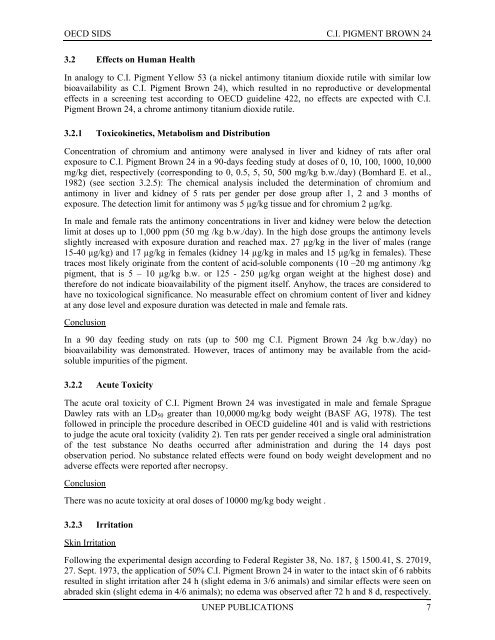C.I. Pigment Brown 24 CAS N°: 68186-90-3
C.I. Pigment Brown 24 CAS N°: 68186-90-3
C.I. Pigment Brown 24 CAS N°: 68186-90-3
You also want an ePaper? Increase the reach of your titles
YUMPU automatically turns print PDFs into web optimized ePapers that Google loves.
OECD SIDS C.I. PIGMENT BROWN <strong>24</strong><br />
3.2 Effects on Human Health<br />
In analogy to C.I. <strong>Pigment</strong> Yellow 53 (a nickel antimony titanium dioxide rutile with similar low<br />
bioavailability as C.I. <strong>Pigment</strong> <strong>Brown</strong> <strong>24</strong>), which resulted in no reproductive or developmental<br />
effects in a screening test according to OECD guideline 422, no effects are expected with C.I.<br />
<strong>Pigment</strong> <strong>Brown</strong> <strong>24</strong>, a chrome antimony titanium dioxide rutile.<br />
3.2.1 Toxicokinetics, Metabolism and Distribution<br />
Concentration of chromium and antimony were analysed in liver and kidney of rats after oral<br />
exposure to C.I. <strong>Pigment</strong> <strong>Brown</strong> <strong>24</strong> in a <strong>90</strong>-days feeding study at doses of 0, 10, 100, 1000, 10,000<br />
mg/kg diet, respectively (corresponding to 0, 0.5, 5, 50, 500 mg/kg b.w./day) (Bomhard E. et al.,<br />
1982) (see section 3.2.5): The chemical analysis included the determination of chromium and<br />
antimony in liver and kidney of 5 rats per gender per dose group after 1, 2 and 3 months of<br />
exposure. The detection limit for antimony was 5 µg/kg tissue and for chromium 2 µg/kg.<br />
In male and female rats the antimony concentrations in liver and kidney were below the detection<br />
limit at doses up to 1,000 ppm (50 mg /kg b.w./day). In the high dose groups the antimony levels<br />
slightly increased with exposure duration and reached max. 27 µg/kg in the liver of males (range<br />
15-40 µg/kg) and 17 µg/kg in females (kidney 14 µg/kg in males and 15 µg/kg in females). These<br />
traces most likely originate from the content of acid-soluble components (10 –20 mg antimony /kg<br />
pigment, that is 5 – 10 µg/kg b.w. or 125 - 250 µg/kg organ weight at the highest dose) and<br />
therefore do not indicate bioavailability of the pigment itself. Anyhow, the traces are considered to<br />
have no toxicological significance. No measurable effect on chromium content of liver and kidney<br />
at any dose level and exposure duration was detected in male and female rats.<br />
Conclusion<br />
In a <strong>90</strong> day feeding study on rats (up to 500 mg C.I. <strong>Pigment</strong> <strong>Brown</strong> <strong>24</strong> /kg b.w./day) no<br />
bioavailability was demonstrated. However, traces of antimony may be available from the acidsoluble<br />
impurities of the pigment.<br />
3.2.2 Acute Toxicity<br />
The acute oral toxicity of C.I. <strong>Pigment</strong> <strong>Brown</strong> <strong>24</strong> was investigated in male and female Sprague<br />
Dawley rats with an LD 50 greater than 10,0000 mg/kg body weight (BASF AG, 1978). The test<br />
followed in principle the procedure described in OECD guideline 401 and is valid with restrictions<br />
to judge the acute oral toxicity (validity 2). Ten rats per gender received a single oral administration<br />
of the test substance No deaths occurred after administration and during the 14 days post<br />
observation period. No substance related effects were found on body weight development and no<br />
adverse effects were reported after necropsy.<br />
Conclusion<br />
There was no acute toxicity at oral doses of 10000 mg/kg body weight .<br />
3.2.3 Irritation<br />
Skin Irritation<br />
Following the experimental design according to Federal Register 38, No. 187, § 1500.41, S. 27019,<br />
27. Sept. 1973, the application of 50% C.I. <strong>Pigment</strong> <strong>Brown</strong> <strong>24</strong> in water to the intact skin of 6 rabbits<br />
resulted in slight irritation after <strong>24</strong> h (slight edema in 3/6 animals) and similar effects were seen on<br />
abraded skin (slight edema in 4/6 animals); no edema was observed after 72 h and 8 d, respectively.<br />
UNEP PUBLICATIONS 7

















